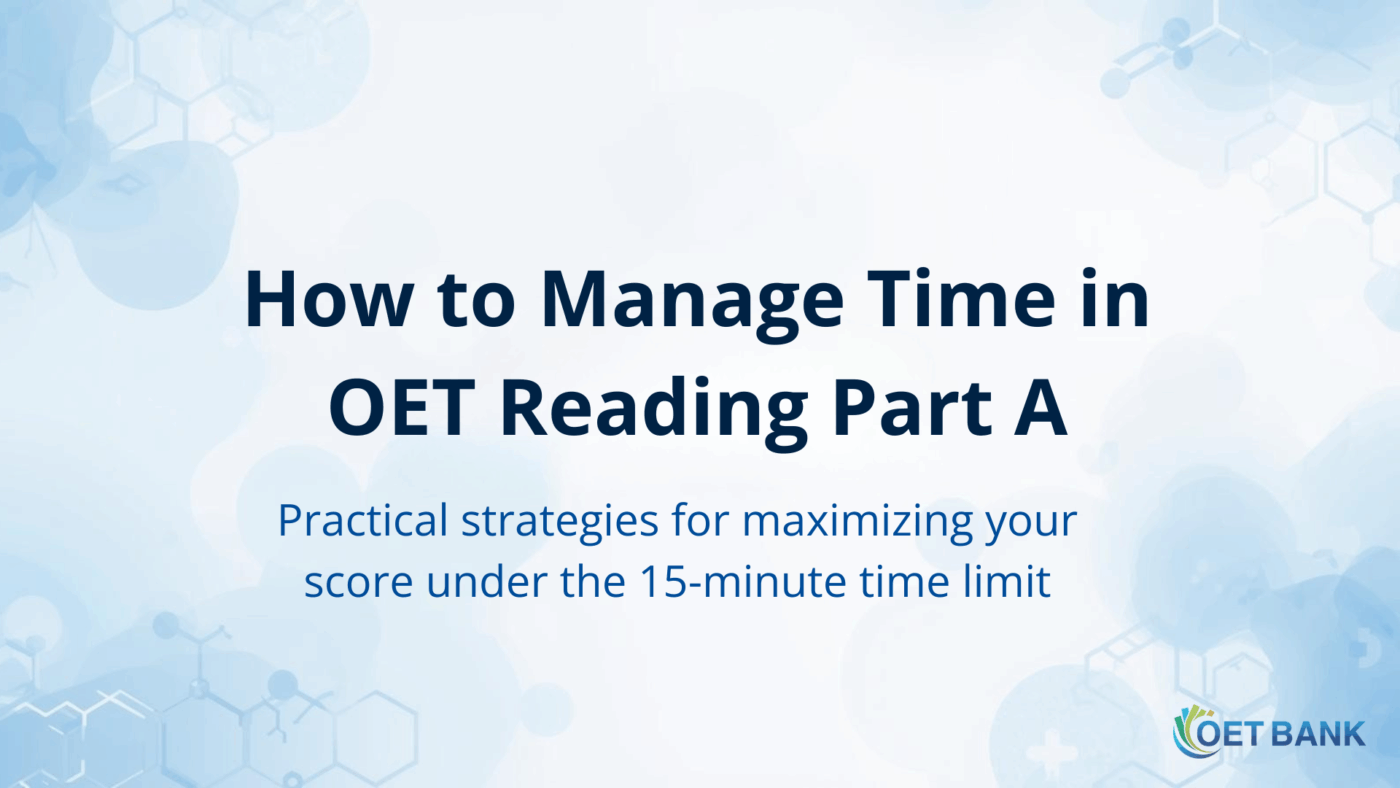OET Strategies, Reading
How to Manage Time in OET Reading Part A
OET Reading performance largely depends on how many points you can secure in Part A.
Among all sections, Part A contains the largest number of questions — and according to official guidance, test-takers who achieve around 30 correct answers in total across the entire Reading sub-test are highly likely to obtain a Grade B (350).
Q. How many questions do I need to get correct for the Reading sub-test?
Test-takers awarded grade B (a scale score of 350) will typically have a score of at least 30 marks.
It is important to note that new reading tests are written for each test session incorporating new material.
This means that the grade boundaries are adjusted slightly for each test to allow for minor differences in the difficulty of items included in that particular version.
The number of marks needed to secure grade B will therefore vary.
Although there’s some variation, it’s clear that Part A is a key scoring opportunity — but it’s also the most time-pressured.
You must answer 20 questions in just 15 minutes, meaning roughly 45 seconds per question.
There’s no single “correct” approach, but here’s a reliable method that many IMGs find effective.
How to Approach OET Reading Part A
Part A presents four short texts (A–D) about a single medical topic, such as symptoms or conditions.
You’ll answer three main question types:
- Matching – Identify which text (A–D) contains the information.
- Short-answer – Respond briefly to direct questions.
- Gap-fill – Insert the correct word or phrase into a blank.
Unlike Parts B and C, Part A focuses on scanning skills — finding information quickly, rather than interpreting meaning or tone.
Step 1: Review All Texts First
Some people start by reading the questions first, others by reading the texts.
Personally, I recommend reading the texts first.
Why? Because once you understand the general layout and topics of each text, you’ll know roughly where to look when you see each question.
If you start from zero (without context), you’ll end up reading back and forth unnecessarily — and that eats up valuable time.
When you’ve previewed the texts, your brain begins linking key ideas automatically.
So when you see a question like “Which leaflet mentions patient dosage?”, you’ll immediately recall:
“Ah, that was probably in Text B or D.”
That simple mental shortcut drastically reduces your total reading load.
Even though it feels like you’re “wasting” the first 30–60 seconds reading, it actually saves you time overall.
Step 2: Start from the Second Section
This may sound counterintuitive, but beginning with Section 2 (short-answer and gap-fill questions) often leads to better time management.
These questions require you to extract exact phrases from the texts, which can be time-consuming.
If you lose time early, you may not finish them — and each missed question means lost points.
By contrast, matching questions (the first section) only require you to select A, B, C, or D.
Even with minimal time left, you can still make quick, educated guesses based on what you remember from your earlier reading.
Typically, by the time you reach the end of the short-answer section, you’ve already reviewed much of the material.
This makes the final matching questions surprisingly fast and accurate — many candidates report 80%+ accuracy using this method.
Step 3: Suggested Time Allocation
Here’s a practical time guide:
- Preview texts: 30–60 seconds each
- Start from Question 7 onward: 30–40 seconds per question
- Finish with Questions 1–6 (matching): Reserve 1 minute to complete them all
Following this pattern makes it easier to stay calm and structured during the 15-minute limit.
Step 4: Focus Areas for Preparation
Part A covers a wide range of general practice topics — but compared with IELTS or TOEFL, the themes are narrower and more predictable.
Strengthening your medical vocabulary and background knowledge greatly reduces the perceived difficulty.
Common topic areas include:
- Hypertension
- Fractures and sprains
- Chronic diseases (e.g., diabetes)
- Allergies
- Seasonal illnesses (e.g., influenza)
- Mental health (e.g., depression, insomnia)
- Skin conditions (e.g., sunburn)
Most questions fall within internal medicine, orthopaedics, psychiatry, dermatology, or paediatrics, so prioritize these.
Step 5: How to Read Faster — the Right Way
Speed comes from accuracy first.
If you chase speed before you can read precisely, your overall consistency and comprehension will suffer — making it harder to achieve balanced scores across all four skills.
Once your foundation is solid, gradually train under time limits.
Push yourself slightly beyond your comfort zone, and you’ll adapt to faster information processing — just like building stamina in sports.
Think of it like swimming or running:
Without the correct form, you’ll plateau quickly no matter how hard you push.
Refine your “form” (reading accuracy), then increase your pace in controlled bursts until your brain adjusts.
Another powerful tool is reading aloud.
When you improve your oral reading fluency, your brain starts processing information at the same speed as spoken English.
That auditory-visual connection enhances both reading speed and listening comprehension — a win-win for OET.
Yesterday, one of my learners asked how to best manage time in Part A — so I decided to summarize it here.
I’ve shared similar advice in multiple places, but it’s worth repeating:
OET Reading success depends less on raw speed and more on strategy and structure.
If you’re preparing for OET, consider exploring our practice resources at OET Bank.
We’re designed not just as mock tests, but as powerful review tools that make it easier to analyze weaknesses and focus on what’s needed to pass.
Explore professional learning materials and courses:
👉 https://oet-bank.com/shop


